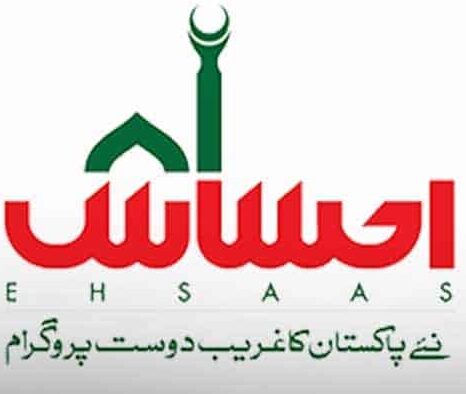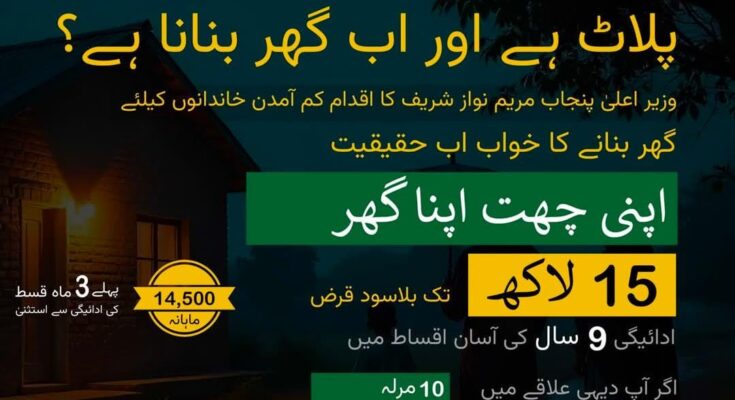Introduction
In a nation where affordable housing remains a pressing challenge for millions, the Punjab government, under the leadership of Chief Minister Maryam Nawaz Sharif, has launched a groundbreaking initiative to address this critical issue. The Apni Chhat Apna Ghar (My Roof, My Home) program, inaugurated on August 14, 2024, is a flagship housing scheme designed to provide affordable homes to low-income families across Punjab, Pakistan’s most populous province. With a goal of delivering 100,000 affordable houses within four and a half years, this ambitious program is poised to transform the housing landscape, offering hope and stability to those who have long struggled with inadequate living conditions. This article explores the origins, objectives, execution models, eligibility criteria, application process, and broader socio-economic impacts of the Apni Chhat Apna Ghar program, highlighting its significance as a model for inclusive development.
Origins and Objectives
The Apni Chhat Apna Ghar program was born out of a recognition that access to safe and affordable housing is a fundamental human right. For many low-income families in Punjab, homeownership has remained an elusive dream, with many residing in rented accommodations, informal settlements, or overcrowded slums. Chief Minister Maryam Nawaz, during the program’s launch in Lahore, emphasized that “owning a home is not just about having a roof over one’s head; it’s about building futures, ensuring stability, and providing a sense of security.”
The primary objective of the program is to facilitate homeownership for 100,000 low-income families by providing affordable housing solutions through interest-free loans and subsidized housing units. The initiative targets financially vulnerable groups, including laborers, small business owners, and government employees with monthly incomes below PKR 60,000, aiming to empower them to live with dignity. Beyond individual benefits, the program seeks to reduce overcrowding, improve access to basic amenities like water, sanitation, and electricity, and foster sustainable, eco-friendly communities. Additionally, it is expected to create approximately 500,000 jobs, boosting Punjab’s economy through construction and related industries.
Execution Models
The Apni Chhat Apna Ghar program is structured around three distinct execution models to cater to diverse housing needs across urban and rural areas:
- Interest-Free Loan Model (70,000 Units): This model targets landowners who own plots of up to 5 marlas in urban areas or 10 marlas in rural areas but lack the financial resources to construct homes. Eligible applicants can receive an interest-free loan of up to PKR 1.5 million, repayable over seven years in monthly installments of approximately PKR 14,000. To ease the financial burden, the government offers a three-month grace period during which no repayments are required. The loans are disbursed in tranches, and repayments sustain a revolving fund to ensure the program’s longevity.
- State Land Development Model (10,000 Units): In this model, the government collaborates with private developers to construct 10,000 housing units on state-owned land through an equity-based land-sharing arrangement. Developers are responsible for infrastructure development, including roads and utilities, while the Punjab Housing and Town Planning Agency (PHATA) provides land use plans and ensures adherence to design standards. This model aims to create sustainable communities with modern amenities.
- Subsidized Housing Model (20,000 Units): This model focuses on providing ready-made homes to homeless or landless families, particularly in urban centers like Lahore, Multan, Faisalabad, Sialkot, Sargodha, and Rawalpindi. The government offers subsidies of up to PKR 1 million per house, making these units affordable for low-income families. Homes are designed with two bedrooms, a TV lounge, a bathroom, and a kitchen, ensuring comfortable living conditions.
These models collectively address the diverse needs of Punjab’s population, from rural landowners to urban slum dwellers, ensuring inclusivity and accessibility.
Eligibility Criteria
To ensure that the program benefits those most in need, the Punjab government has established clear eligibility criteria:
- Residency: Applicants must be permanent residents of Punjab, verified through their Computerized National Identity Card (CNIC) and a valid Punjab domicile.
- Income: The program targets low-income families with a monthly income of less than PKR 60,000, prioritizing those living below the poverty line.
- Land Ownership: For the loan model, applicants must own a plot of up to 5 marlas in urban areas or 10 marlas in rural areas. For the subsidized housing model, landless or homeless individuals are prioritized.
- NSER Registration: Applicants must be registered with the National Socio-Economic Registry (NSER) and have a Proxy Means Test (PMT) score of 60 or lower, indicating economic vulnerability.
- No Criminal Record: Applicants must have no criminal record or financial defaults.
- Age: For similar schemes like Ehsaas Apna Ghar in Khyber-Pakhtunkhwa, age restrictions (18–55 years) apply, but no specific age limit has been mentioned for Apni Chhat Apna Ghar.
These criteria ensure that the program reaches the most deserving beneficiaries, fostering equity and transparency.
Application Process
The application process for Apni Chhat Apna Ghar is designed to be user-friendly and accessible, with both online and offline options to accommodate varying levels of digital literacy. Here is a step-by-step guide:
- Visit the Official Portal: Applicants can access the program’s online portal at acag.punjab.gov.pk. New users must create an account by providing their CNIC number, full name, father’s or husband’s CNIC, gender, email address, mobile number, division, district, tehsil, city, and a secure password.
- Complete the Citizen Registration Form: After registration, applicants must fill out a detailed form with personal and household information, ensuring all details are accurate to avoid rejection. A certificate form follows, where applicants certify the authenticity of their information and acknowledge that false data may lead to disqualification or legal action.
- Submit Required Documents: Applicants must upload clear, original copies of the following documents:
- National Identity Card (CNIC)
- Proof of property ownership (for the loan model)
- Proof of monthly income (e.g., salary slips or bank statements)
- Residence verification
- Filled application form
- NSER Verification: If an applicant’s PMT record is not found in the NSER database, they must visit the nearest NSER office to register and obtain a PMT score.
- Application Submission: Once all forms and documents are completed, applicants submit their application via the portal. They can track their application status by logging in with their CNIC and password.
- Offline Option: For those unable to apply online, registration desks are available at Deputy Commissioner offices across Punjab’s 36 districts. Applicants must bring all required documents for in-person submission.
- Verification and Approval: The Punjab Housing and Town Planning Agency (PHATA) conducts surveys to verify applicant information. Successful candidates are notified, and loan disbursements or housing allocations follow.
The program’s helpline (0800-09100, 042-99213419, 042-99213428) and email ([email protected]) provide support for queries or issues during the application process.
Progress and Impact
Since its launch, the Apni Chhat Apna Ghar program has made significant strides. As of January 2025, over 5,000 residents have availed loans, and 4,200 houses are nearing completion. The Punjab government, in collaboration with the Ravi Urban Development Authority (RUDA) and the Housing and Urban Development Department, has approved PKR 62 billion to provide loans to 40,000 individuals by May 2025. Chief Minister Maryam Nawaz has also directed officials to explore increasing the loan amount to PKR 2 million to accommodate rising construction costs.
The program’s socio-economic impact is profound. By providing affordable housing, it reduces homelessness and improves living standards, particularly for women, children, and marginalized communities. The construction of 100,000 houses is expected to create jobs in construction, manufacturing, and logistics, stimulating economic growth. Additionally, the focus on sustainable housing—using high-quality, eco-friendly materials and building near city limits for better access to services—ensures long-term benefits for residents and the environment.
Social media posts on X reflect public enthusiasm, with users praising the program’s interest-free loans and affordable installments. For instance, one post noted that 28,837 families are benefiting, with 25,519 homes under construction, highlighting the program’s rapid progress.
Challenges and Future Directions
Despite its successes, the Apni Chhat Apna Ghar program faces challenges. Some applicants have reported issues with NSER registration or delays in application processing, while others have expressed concerns about the accessibility of helpline services. To address these, the government must enhance digital infrastructure, streamline verification processes, and expand offline support for rural applicants.
Looking ahead, the program aims to scale up its impact by expanding to more districts and refining its execution models based on feedback. The proposed increase in loan amounts and continued collaboration with private developers will further enhance affordability and reach. Additionally, integrating renewable energy solutions, such as solar panels, could align the program with Punjab’s broader sustainability goals.
Conclusion
The Apni Chhat Apna Ghar program is a beacon of hope for Punjab’s low-income families, offering a pathway to homeownership and dignity. By combining interest-free loans, subsidized housing, and sustainable development, it addresses the multifaceted challenges of housing insecurity. As the program progresses, it has the potential to set a precedent for other provinces in Pakistan and beyond, demonstrating that inclusive, government-led initiatives can transform lives. For the people of Punjab, Apni Chhat Apna Ghar is not just about building houses—it’s about building a brighter, more equitable future.




